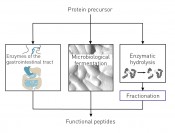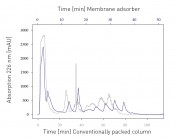|
Bio&Biotech
 >
Fractionation of functional peptides with ion-exchange membrane adsorption chromatography
>
Fractionation of functional peptides with ion-exchange membrane adsorption chromatography
Fractionation of functional peptides with ion-exchange membrane adsorption chromatographySeparation via bindingBy deploying specific proteases for the enzymatic hydrolysis of proteins, the release of peptides can be controlled. This process can be used to produce functional peptides, which may exhibit an ability to reduce blood pressure or have a surface-active function. The deployment of biofunctional peptides in food as an “added value” is only possible at sufficiently effective concentrations, however. Accordingly, processes are required that enable the production and selective concentration of such functional peptides. Arterial hypertonia – or high blood pressure in common parlance – is one of the primary risk factors for cardiovascular disease. One contemporary treatment for this disorder involves blocking the angiotensin converting enzyme (ACE), a key enzyme that is ascribed a significant role in the renin-angiotensin system. By cleavage of the decapeptide angiotensin I, it catayses its conversion to angiotensin II, thus causing an increase in blood pressure. Over the last few years, the use of ACE inhibitors has proved to be a successful treatment for arterial hypertonia. Since these drugs often produce side effects, the inclusion of ACE inhibitors in low concentrations in foodstuffs has attracted a great deal of interest. Termed “functional foods”, these not only provide nutrition but also offer an additional positive benefit for the health of the person consuming them. To be able to achieve such an effect, however, sufficient concentrations of the functional peptides are required in the relevant types of foods. Production of functional peptides The release of functional peptides from proteins can be achieved in a number of ways (fig. 1). First of all, the use of a suitable protein precursor is necessary, embedding the functional peptides in its amino acid sequence. In recent years, milk proteins – and whey proteins in particular – have distinguished themselves in research as protein precursors for a wide range of functional peptides. These proteins release a series of active peptides during the process of digestion in the gastrointestinal tract, although the concentration of these peptides is too low to achieve a significant positive effect.
Fig. 1: Production of functional peptides via proteolysis.
One method that is designed to achieve the targeted release of functional peptides from milk proteins is fermentation with specialised starter cultures. In this process, enzymes from the microorganisms lead to an increase in the production of the ACE-inhibiting peptides IPP and VPP. In one case, involving the Finnish market, a range of fermented milk products were developed that had proven capable of achieving a slight reduction in blood pressure in clinical trials. If there is a need to include such functional peptides in other foodstuffs, however, then these need to be added to the food product. One option for harvesting functional peptides from natural raw materials is enzymatic hydrolysis. As one example, tryptic hydrolysis of the major whey protein ß-lactoglobulin enables the release of the ACE-inhibiting peptides f(9–14) and f(142–148) [1]. Fractionation of hydrolysates Enzymatic hydrolyses always generate a complex mixture of various peptides, however, even when deploying specific enzymes and maintaining constant reaction conditions. In addition, the hydrolysates may contain not only the desired peptides but also peptides with negative properties such as a bitter flavour, for example. Accordingly, the production of functional components also requires procedures that permit the separation of other kinds of peptides while concentrating the bioactive peptides. Since the peptides of the total tryptic hydrolysate of ß-lactoglobulin have similar molecular weights, however, fractionation of the peptides using established separation procedures such as membrane filtration is barely feasible. Methods are therefore required that enable a fractionation of the molecules based on their specific physical and chemical properties. Currently, there is only one approach to this kind of selective fractionation of individual components from a complex peptide mixture: packed chromatography columns. This approach is very limited in its throughput, however. Membrane adsorption chromatography (MAC) offers a new and more powerful alternative to traditional liquid chromatography (see sidebar). Ion-exchange membrane adsorption chromatography To enable a selective separation of the ACE-inhibiting peptides from the complex ß-lactoglobulin hydrolysate, the process of ion-exchange membrane adsorption chromatography (IE-MAC) was used. While analyte separation in MAC follows the same principles as used in conventional ion exchange chromatography, MAC offers the key advantages of significantly higher flow rates and a reduced process time [3]. It was also possible to demonstrate this in the fractionation of hydrolysates, using a selection of anion exchange chromatography columns in the form of a conventionally packed column and a membrane adsorber. Figure 2 presents the chromatograms of the two fractionation methods.
Fig. 2: Comparison of the fractionation of a ß-lactoglobulin hydrolysate by utilising a conventionally packed anion exchanger column “Mono Q 5/50 GL” (grey line) and the membrane-based anion exchanger “Sartobind Q” (blue line); fractionation conditions: 0.03M phosphate buffer, pH7, flow rate Mono Q: 1ml/min, flow rate Sartobind Q: 5ml/min.
While the fractionation of the hydrolysate using the packed chromatography column method completed only after about 80 minutes, separation of the fractions using the membrane adsorber method was achieved after just 40 minutes. In addition, MAC also achieved superior selectivity of the individual fractions, despite higher flow rates. As a result of these properties and the membrane adsorber’s modular construction, which makes it simple to scale up the procedure, MAC offers the food industry a selective and economically appealing separation technique. Fractionation of the ß-lactoglobulin tryptic hydrolysate The starting substrate for the fractionation process was provided by the total tryptic hydrolysate of ß-lactoglobulin, which contains 17 other peptides in addition to the ACE-inhibiting peptides mentioned. The optimised procedure for the fractionation of the hydrolysate using IE-MAC requires the deployment of an anion exchanger (AE) as its first step. As a result of the hydrolysate’s complex composition and the correspondingly broad spectrum of isoelectric points, not all peptides bind to the AE, and are collected as flow-through (AE FT). Peptides with a negative charge bind to the AE, however, and can be separated into a total of seven fractions (AE 1 to AE 7) by means of an ionic strength gradient. In a second step, the AE FT is passed through a cation exchanger (CE) and a total of five fractions (CE 1 to CE 5) are thereby obtained, again by utilising an ionic strength gradient. In addition, this step also obtains a further fraction with non-binding peptides in the flow-through of the cation exchanger (CE FT). Overall, then, the use of the two ion exchangers enables the fractionation of the hydrolysate into 13 fractions. To investigate the results of fractionation, it was first necessary to characterise the peptide composition of the individual fractions. Mass spectrometry was used to quantify the peptides contained in the fractions, and the volume of ACE-inhibiting peptides f(9–14) and f(142–148) harvested was calculated as a percentage proportion of the hydrolysate deployed. Figure 3 presents the chromatograms obtained from the chromatography processes, plus the percentage proportion of the target peptides in the individual fractions [4].
Fig. 3: Chromatograms of the fractionation process developed using coupled anion (A) and cation ion-exchange (B) membrane adsorption chromatography, also showing the percentage content of ACE-inhibiting peptides f(9–14) and f(142–148) obtained from the fractions harvested (modified after [4]).
Clearly discernible is the fact that successful concentration of the ACE-inhibiting peptides was achieved, especially in the cation exchanger fractions. Here, the peptide fragment f(9–14) was concentrated primarily in the flow-through (CE FT) – i.e. in the fraction of non-binding peptides – and in the first fraction (CE 1), while the peptide f(142–148) is principally found in the second and third fractions (CE 2–3) of the cation exchanger. In order to exclude antagonistic effects of other peptides contained in the fractions on the potency of ACE inhibition, the ACE-inhibiting activity of the fractions was investigated in vitro.
Fig. 4: Reduction of IC50 values in the fractions obtained with the cation exchanger compared to the hydrolysate originally deployed; CE FT: anion exchanger flow through, CE 1 to CE 3: fractions 1–3 of the anion exchange process (modified after [5]).
In vitro analysis of ACE-inhibiting activity This analysis applied the calculation of IC50 values to determine the inhibitory potency of the hydrolysate overall and of the fractions obtained with the maximum volume of ACE-inhibiting peptides. This IC50 value is the concentration at which half-maximal inhibition of the ACE is achieved. As the IC50 values decrease, this corresponds to an increase in the potency of ACE inhibition. Figure 4 presents the reduction in IC50 values achieved by the fractions investigated with a maximum volume of the ACE-inhibitory peptides f(9–14) and f(142–148) compared to the total hydrolysate. As can be seen, the fractionation of the hydrolysate by means of IE-MAC leads to a considerable enhancement in the ACE-inhibitory properties. For fraction CE 2, for example, the IC50 value is reduced to 40% of its initial value, with fraction CE 3 achieving a reduction of 30%. The findings presented here clearly demonstrate that IE-MAC can be successfully deployed for the fractionation of ACE-inhibiting peptides from the complex ß-lactoglobulin hydrolysate. The fractions thereby harvested could then be deployed following clinical testing or safety approvals as foodstuffs (nutraceuticals or e.g. novel foods) containing peptides for lowering blood pressure.
Bibliography Picture: © fotolia.com | ty4ina |
L&M int. 1 / 2015
Free download here: download here The Authors:Read more articles online |


















